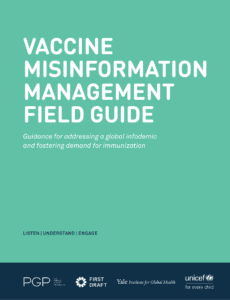Misinformation Alerts
Knowing what misinformation is being shared can help you generate effective messaging.
These insights are based on a combination of automated media monitoring and manual review by public health data analysts. Media data are publicly available data from many sources, such as social media, broadcast television, newspapers and magazines, news websites, online video, blogs, and more. Analysts from the Public Good Projects triangulate this data along with other data from fact checking organizations and investigative sources to provide an accurate, but not exhaustive, list of currently circulating misinformation.
Misinformation Alerts
Knowing what misinformation is being shared can help you generate effective messaging.
These insights are based on a combination of automated media monitoring and manual review by public health data analysts. Media data are publicly available data from many sources, such as social media, broadcast television, newspapers and magazines, news websites, online video, blogs, and more. Analysts from the Public Good Projects triangulate this data along with other data from fact checking organizations and investigative sources to provide an accurate, but not exhaustive, list of currently circulating misinformation.Alerts are categorized as high, medium, and low risk.
- High risk alerts: Narratives with widespread circulation across communities, high engagement, exponential velocity, and a high potential to impact health decisions. Are often more memorable than accurate information.
- Medium risk alerts: Narratives that are circulating in priority populations and pose some threat to health. Potential for further spread due to the tactics used or because of predicted velocity. Often highlights the questions and concerns of people.
- Low risk alerts: Narratives that are limited in reach, don’t impact your community, or lack the qualities necessary for future spread. May indicate information gaps, confusion, or concerns.
A TikTok video asks viewers to visit a website which features a compilation of vaccine-related blogs, news stories, and peer-reviewed articles. The website is purported to have been created by a toxicologist (unverified). Within each of the materials on the website, cherry picked sentences have been highlighted to draw the reader's eye to specific statements that are intended to sow doubt in the safety and efficacy of various vaccines. By cherry picking data and neglecting context, the website uses a common tactic of manipulating data to claim that vaccines are unsafe and ineffective.
Recommendation: Addressing this misinformation could distract from priority talking points. Fact Checking Source(s): N/A
On the controversial online forum 8Kun (formerly called 8chan), a QAnon message board is starting a “meme campaign” to spread false information that the KKK is behind distribution of the COVID-19 vaccine, as a way to deter Black people from getting vaccinated.
Recommendation: Focusing on white supremacist’s actions in this case could distract from priority talking points regarding vaccine safety and efficacy, the equity of vaccine distribution, disproportionate risk of mortality from COVID-19 among African Americans, and structural racism. Fact Checking Source(s):N/A
A blog from an acupuncturist is circulating on social media, claiming that a solution of baking soda and water is an inexpensive and effective treatment for those with COVID-19. Fact checking organizations and health authorities have clarified this is not an approved treatment. This claim is similar to others that have circulated during the pandemic, such as the false claims drinking lemon juice and baking soda, or gargling with baking soda and hot water, can cure COVID-19.
Recommendation: While addressing this misinformation could distract from priority talking points, updating FAQs and informational resources to list approved treatments and discourage the use of unapproved treatments, if not done so already, is recommended. Fact Checking Source(s): covid19treatmentguidelines.nih.gov
An organization with a history of fighting vaccine mandates has declared intent to file a lawsuit against CDC, claiming that CDC's website inaccurately states that there is no link between vaccines and autism. Research has repeatedly shown that vaccines do not cause autism. The declaration has led to a spike in related misinformation.
Recommendation: Addressing this misinformation could distract from priority talking points. Fact Checking Source(s): cdc.gov
In a now-removed but widely shared Facebook video, a man claims that the Oxford-AstraZeneca vaccine is an mRNA vaccine, and can make changes to the recipient’s genetic material. The Oxford-AstraZeneca vaccine is not an mRNA vaccine, and claims that such vaccines change genetic material have been repeatedly debunked by fact checking organizations and health authorities.
Recommendation: While addressing this misinformation could distract from priority talking points, updating FAQs and informational resources to explain the science and role of mRNA in vaccines is recommended. There continues to be substantial confusion among the public, and among health professionals, regarding mRNA. Fact Checking Source(s):reuters.com
A widely shared article from an anti-vaccine group states that one-third of deaths reported to the CDC occurred within 48 hours of COVID-19 vaccination, implying that vaccination was the cause of death. This conclusion was made using data from the Vaccine Adverse Reporting System (VAERS). This post continues a trend of incorrectly using self-reported VAERS data to draw causal links between vaccines and adverse health events. The VAERS is a passive surveillance system in which any individual can self-report any health problem following self-reported immunization. VAERS is the official US vaccine adverse event reporting system, maintained and monitored by the U.S. Department of Health and Human Services. However, reports to the VAERS do not determine if a vaccine caused a reaction or death; if a report is found to have merit, it begins the first of many subsequent steps taken by health officials to investigate adverse events.
Recommendation: VAERS and other sources of self-reported morbidity and mortality allegedly due to COVID-19 vaccines are increasingly of interest to anti-vaccine groups, conspiracy groups, and to individuals practicing armchair epidemiology. Interest is expected to continue, so public health talking points should continue to regularly promote vaccines and their safety and efficacy, and familiarity with the US’ vaccine adverse event reporting system is encouraged for public health communicators: https://vaers.hhs.gov/ Fact Checking Source(s):vaers.hhs.gov, fullfact.org
Claims that wearing a mask will cause respiratory complications are widespread, such as hypoxia and bacterial pneumonia. According to the CDC, there is no risk of hypoxia or pneumonia in healthy adults who wear a mask. And while bacteria can accumulate on masks over time, this risk is eliminated by switching out disposable masks or regularly washing reusable ones.
Recommendation: While directly addressing this misinformation could distract from priority talking points, updating informational materials to address general questions related to frequent mask wearing, if not done so already, is recommended. CDC’s Your Guide to Masks has helpful information: https://www.cdc.gov/coronavirus/2019-ncov/prevent-getting-sick/about-face-coverings.html Fact Checking Source(s): mayoclinichealthsystem.org
A widely circulating post on social media states that increases in Sudden Infant Death Syndrome (SIDS) began after vaccines became more widely available in the 1950s. The post uses a quote from a discredited physician who has published now-discredited vaccine research. Vaccines have not been shown to cause SIDS. Health researchers have previously documented that anti-vaccine organizations and advocates routinely reach out to mothers who have lost infants due to SIDS. Understandably intense feelings of grief and loss are capitalized upon to recruit women to the anti-vaccine movement, by claiming vaccines caused their child’s death rather than accidental or unknown causes. This tactic is expected to increase as more women receive COVID-19 vaccines.
Recommendation: Continuing to promote the safety and efficacy of vaccines, and the importance of public health measures, is in itself refuting this misinformation. Fact Checking Source(s): nbcnews.com, cdc.gov
A registered nurse practitioner has claimed in a video that mRNA technology, such as that found in COVID-19 vaccines, will teach the body to attack itself, leading to the development of autoimmune disease. The video has been seen hundreds of thousands of times on social media.
Recommendation: While addressing this misinformation could distract from priority talking points, updating FAQ’s and informational resources to explain the science and role of mRNA in vaccines is recommended. There continues to be substantial confusion among the public, and among health professionals, regarding mRNA. Fact Checking Source(s):apnews.com
A video was live-streamed on Facebook and has received tens of thousands of views, in which a woman records a screen share of data reported to the Vaccine Adverse Events Reporting System (VAERS). The woman incorrectly claims that COVID-19 vaccines cause adverse health reactions, including deaths. The VAERS is a passive surveillance system in which any individual can self-report any health problem following self-reported immunization. VAERS is the official US vaccine adverse event reporting system, maintained and monitored by the U.S. Department of Health and Human Services. However, reports to the VAERS do not determine if a vaccine caused a reaction or death; if a report is found to have merit, it begins the first of many subsequent steps taken by health officials to investigate adverse events.
Recommendation: VAERS and other sources of self-reported morbidity and mortality allegedly due to COVID-19 vaccines are increasingly of interest to anti-vaccine groups, conspiracy groups, and to individuals practicing armchair epidemiology. Interest is expected to continue, so public health talking points should continue to regularly promote vaccines and their safety and efficacy, and familiarity with the US’ vaccine adverse event reporting system is encouraged for public health communicators: https://vaers.hhs.gov/ Fact Checking Source(s): reuters.com
Alerts are categorized as high, medium, and low risk.
- High risk alerts: Narratives with widespread circulation across communities, high engagement, exponential velocity, and a high potential to impact health decisions. Are often more memorable than accurate information.
- Medium risk alerts: Narratives that are circulating in priority populations and pose some threat to health. Potential for further spread due to the tactics used or because of predicted velocity. Often highlights the questions and concerns of people.
- Low risk alerts: Narratives that are limited in reach, don’t impact your community, or lack the qualities necessary for future spread. May indicate information gaps, confusion, or concerns.
Vaccine Misinformation Guide
Get practical tips for addressing misinformation in this new guide. Click image to download, or see highlights.

